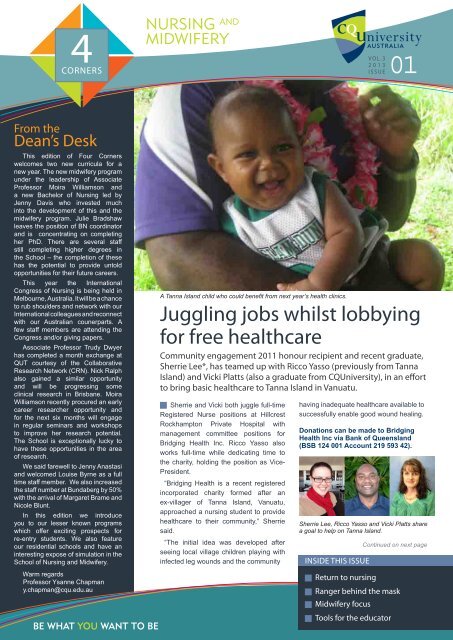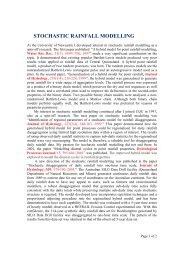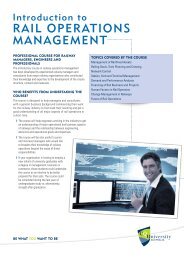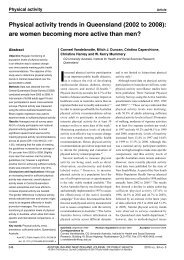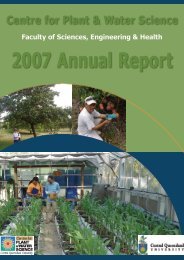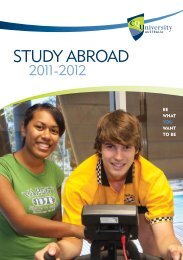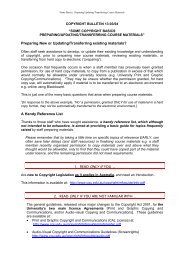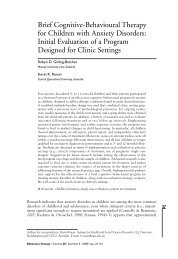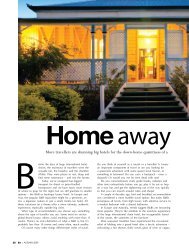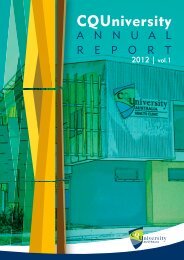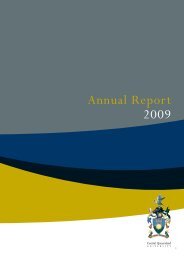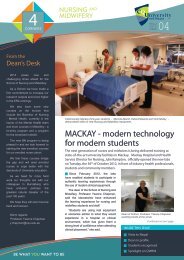4 Corners Newsletter - Vol 5 - Central Queensland University
4 Corners Newsletter - Vol 5 - Central Queensland University
4 Corners Newsletter - Vol 5 - Central Queensland University
Create successful ePaper yourself
Turn your PDF publications into a flip-book with our unique Google optimized e-Paper software.
4<br />
CORNERS<br />
VOL.3<br />
2013<br />
ISSUE01<br />
From the<br />
Dean’s Desk<br />
This edition of Four <strong>Corners</strong><br />
welcomes two new curricula for a<br />
new year. The new midwifery program<br />
under the leadership of Associate<br />
Professor Moira Williamson and<br />
a new Bachelor of Nursing led by<br />
Jenny Davis who invested much<br />
into the development of this and the<br />
midwifery program. Julie Bradshaw<br />
leaves the position of BN coordinator<br />
and is concentrating on completing<br />
her PhD. There are several staff<br />
still completing higher degrees in<br />
the School – the completion of these<br />
has the potential to provide untold<br />
opportunities for their future careers.<br />
This year the International<br />
Congress of Nursing is being held in<br />
Melbourne, Australia. It will be a chance<br />
to rub shoulders and network with our<br />
International colleagues and reconnect<br />
with our Australian counerparts. A<br />
few staff members are attending the<br />
Congress and/or giving papers.<br />
Associate Professor Trudy Dwyer<br />
has completed a month exchange at<br />
QUT courtesy of the Collaborative<br />
Research Network (CRN). Nick Ralph<br />
also gained a similar opportunity<br />
and will be progressing some<br />
clinical research in Brisbane. Moira<br />
Williamson recently procured an early<br />
career researcher opportunity and<br />
for the next six months will engage<br />
in regular seminars and workshops<br />
to improve her research potential.<br />
The School is exceptionally lucky to<br />
have these opportunities in the area<br />
of research.<br />
We said farewell to Jenny Anastasi<br />
and welcomed Louise Byrne as a full<br />
time staff member. We also increased<br />
the staff number at Bundaberg by 50%<br />
with the arrival of Margaret Brame and<br />
Nicole Blunt.<br />
In this edition we introduce<br />
you to our lesser known programs<br />
which offer exciting prospects for<br />
re-entry students. We also feature<br />
our residential schools and have an<br />
interesting expose of simulation in the<br />
School of Nursing and Midwifery.<br />
Warm regards<br />
Professor Ysanne Chapman<br />
y.chapman@cqu.edu.au<br />
A Tanna Island child who could benefit from next year’s health clinics.<br />
Juggling jobs whilst lobbying<br />
for free healthcare<br />
Community engagement 2011 honour recipient and recent graduate,<br />
Sherrie Lee*, has teamed up with Ricco Yasso (previously from Tanna<br />
Island) and Vicki Platts (also a graduate from CQ<strong>University</strong>), in an effort<br />
to bring basic healthcare to Tanna Island in Vanuatu.<br />
Sherrie and Vicki both juggle full-time<br />
Registered Nurse positions at Hillcrest<br />
Rockhampton Private Hospital with<br />
management committee positions for<br />
Bridging Health Inc. Ricco Yasso also<br />
works full-time while dedicating time to<br />
the charity, holding the position as Vice-<br />
President.<br />
“Bridging Health is a recent registered<br />
incorporated charity formed after an<br />
ex-villager of Tanna Island, Vanuatu,<br />
approached a nursing student to provide<br />
healthcare to their community,” Sherrie<br />
said.<br />
“The initial idea was developed after<br />
seeing local village children playing with<br />
infected leg wounds and the community<br />
having inadequate healthcare available to<br />
successfully enable good wound healing.<br />
Donations can be made to Bridging<br />
Health Inc via Bank of <strong>Queensland</strong><br />
(BSB 124 001 Account 219 593 42).<br />
Sherrie Lee, Ricco Yasso and Vicki Platts share<br />
a goal to help on Tanna Island.<br />
INSIDE THIS ISSUE<br />
Return to nursing<br />
Continued on next page<br />
Ranger behind the mask<br />
Midwifery focus<br />
Tools for the educator
Healthcare Continued from previous page<br />
“From this observation, planning commenced to develop a charity<br />
to meet the community’s needs of providing basic healthcare.<br />
This vision is to help less fortunate communities by offering<br />
healthcare by qualified health care professionals, instigating a<br />
healthier future.”<br />
Bridging Health Inc is now planning free health clinics, with the<br />
first scheduled for June/July next year, allowing ample time to<br />
prepare and gather resources.<br />
“Bridging Health Inc will undertake various fundraising activities,<br />
allowing for the purchase of much needed resources, as well<br />
as recruiting many enthusiastic and qualified healthcare and<br />
non-healthcare professionals,” Sherrie said. These fundraising<br />
activites will include Golf Days and Movie Nights.<br />
Bridging Health Inc is now also on Facebook<br />
To participate or for more information, contact Sherrie at<br />
0438 121 617 or infobridginghealthinc@gmail.com.<br />
* Sherrie Lee was one of 18 students and three lecturers who travelled to Nepal in 2011. She<br />
outlined the advantages of providing health care and assistancce in a third world country and<br />
the learning experiences of students as a result of that mission and was awarded a community<br />
engagement honour at the Vice-Chancellor’s Staff Award (Opal Award) for her role in the project.<br />
New program addressing the gaps<br />
Transitioning from the TAFE Diploma for Enrolled Nurses to university study<br />
requires specialised teaching. As the TAFE-qualified students come directly into<br />
the second year of the CQ<strong>University</strong> Nursing degree, the new program is designed<br />
to address gaps in their specialised knowledge.<br />
The new program ensures that the transitioning students acquire a high order critical thinking<br />
approach to their studies, while at the same time acknowledging skills they bring from their<br />
previous study and work life.<br />
Recently, around 60 distance education students, transitioning from being Enrolled Nurses to<br />
university life, converged on Noosa Campus to attend their first residential schools. Kelly Inglis<br />
from the School of Medical and Applied Sciences partnered with nursing teaching staff and made<br />
a significant contribution to the teaching and understanding of the Sciences for the transitional<br />
students. The residential schools allowed them to hone their reasoning, critical thinking and<br />
collaboration skills while absorbing specialised knowledge and forming study relationships with<br />
other Enrolled Nurses.<br />
Noosa academic Carol McPherson, Lecturer and Transition to Nursing Studies Course<br />
Coordinator, said the residential schools were a success as they helped students gain<br />
confidence about their study requirements and future career aspirations.<br />
Residential School Participants<br />
2
Re-entry to re-start<br />
Many nurses take a break to have families or to try new career options,<br />
whilst remaining hopeful of later returning to nursing despite the<br />
challenging employment climate in <strong>Queensland</strong>’s health sector. Whatever<br />
the choice, they need to refresh their skills before coming back onto what is<br />
a fast-changing profession.<br />
Former nurses who are keen to return can<br />
now apply for a Registered Nurse Re-Entry<br />
to Practice Course offered by distance<br />
education, with online study.<br />
One of the hopeful nurses is Sharon van<br />
der Draai, based in the Brisbane suburb<br />
of Banyo. Sharon recently completed her<br />
Registered Nurse Re-Entry to Practice<br />
Course online through CQ<strong>University</strong>,<br />
including 160 hours of practicums at Prince<br />
Charles Hospital and a three-day residential<br />
school refresher at Noosa.<br />
This CQ<strong>University</strong> course can arrange<br />
clinical placements in the applicant’s home<br />
region. It’s the only course of its type in<br />
<strong>Queensland</strong> and one of only a few in<br />
Australia available via distance education.<br />
CQ<strong>University</strong>’s course has been approved<br />
by the Australian Health Practitioners<br />
Registration Agency (AHPRA) and was<br />
also accredited via the Australian Nursing &<br />
Midwifery Accreditation Council (ANMAC).<br />
Details for scholarships (each valued<br />
at $6000) are available via the Australian<br />
College of Nursing website www.rcna.org.<br />
au/WCM/.<br />
The Health CRN is in partnership with<br />
researchers from Curtin <strong>University</strong>,<br />
QUT and UQ and is funded through the<br />
Australian Government’s Collaborative<br />
Research Networks (CRN) Program.<br />
Visit http://www.cqu.edu.au/research/<br />
research-organisations/health-crn for more<br />
information.<br />
Residential School<br />
for distance<br />
students<br />
Twenty-nine first-year Nursing<br />
students, studying by distance<br />
education, spent time learning<br />
important skills, as part of their first<br />
residential school program at the<br />
CQ<strong>University</strong> Mackay Nursing and<br />
Midwifery Laboratories recently.<br />
Students travelled from around the<br />
country, including Townsville, the<br />
Atherton Tablelands and NSW.<br />
Residential School and Nursing<br />
Lecturer, Sandy McLellan, said the<br />
students learnt about washing a<br />
patient in bed and in the shower,<br />
bedpan use, manual handling,<br />
patient observations, patient<br />
feeding, communication skills,<br />
documentation, holistic care and<br />
much more.<br />
In Term 2, after the next<br />
residential school, the students<br />
will be participating in their clinical<br />
placement.<br />
Banyo mum, Sharon van der Draai, completed<br />
her Registered Nurse Re-Entry to Practice<br />
Course online through CQUni, December 2012.<br />
She’s relieved to have refreshed her<br />
nursing qualification within the mandatory<br />
10-year timeframe.<br />
Sharon started out as a hospital-trained<br />
nurse in 1990 and subsequently also<br />
completed a nursing degree. She worked<br />
until 2002 but then took a break to bring up<br />
her two boys.<br />
Nowadays, the family is very busy with<br />
camping, hiking and outdoor pursuits<br />
but Sharon is still keen to return to the<br />
workforce.<br />
Students learn how<br />
to correctly make a<br />
bed for the clinical<br />
environment.<br />
Nursing student<br />
Jayde Luke passes<br />
the Registered Nurse<br />
Re-Entry to Practice<br />
scrub test.<br />
Details for the Registered Nurse Re-Entry<br />
to Practice Course are via the Centre for<br />
Professional Health Education website at<br />
www.cqu.edu.au/engage/cphe . Prospective<br />
students should contact the CPHE in the<br />
first instance.<br />
3
Academic<br />
workshops<br />
for students<br />
in Emerald<br />
Students in the Emerald<br />
region have benefited greatly from<br />
attending academic workshops<br />
at the Emerald Learning Centre<br />
under the direction of Nursing and<br />
Midwifery lecturer Teresa Sander.<br />
“Distance education is often the<br />
best option for people who are<br />
looking for flexibility,” Teresa said,<br />
“and we need to ensure all of<br />
our students, both internal and<br />
distance, can reach their potential<br />
by providing academic assistance<br />
for them.”<br />
The workshops provide advice<br />
on referencing and academic<br />
writing while providing the chance<br />
for students to network with their<br />
peers. This helps reduce stress<br />
levels and develops a sense of<br />
belonging.<br />
Teresa has timetabled the<br />
workshops on weekends to<br />
allow working students to attend.<br />
Whether students have questions<br />
regarding course profiles or<br />
assessment tasks, the workshops<br />
aim to assist them in fulfilling the<br />
course requirements.<br />
The workshops have been very<br />
well received by students who<br />
have attended and have produced<br />
some excellent feedback.<br />
“This workshop was excellent<br />
and helped me so much. I don’t<br />
think I would have written my<br />
first assessment with such<br />
confidence if I hadn’t<br />
attended this,” said Arts<br />
student, Melanie Ohl.<br />
Teresa Sander, Nursing and<br />
Midwifery Lecturer, intends<br />
to continue running regular<br />
workshops at the Emerald<br />
Learning Centre for any<br />
students who wish to attend.<br />
Gaining midwifery knowledge and<br />
skills relevant to regional Qld<br />
Educating midwives for regional <strong>Queensland</strong> is the ongoing focus for<br />
CQ<strong>University</strong>’s new Midwifery program, as commencing students learnt from<br />
the industry’s best at ‘meet and greet’ sessions recently.<br />
The ‘meet and greet’ sessions were part of residential schools for students commencing the<br />
Graduate Diploma of Midwifery - a unique program designed as an educational pathway for<br />
registered nurses to become midwives.<br />
CQ<strong>University</strong>’s new Head of Program, Midwifery, Associate Professor Moira Williamson**,<br />
said the intake of midwifery students for 2013 will be the first to experience a relaunched<br />
program, helping them gain midwifery knowledge and skills relevant to regional <strong>Queensland</strong>.<br />
Assoc Prof Williamson said the Continuity<br />
of Care (CoC) and rural and cultural<br />
diversity aspects of the program will<br />
prepare students for a range of working<br />
environments.<br />
“The CoC experience is a learning<br />
strategy where a student midwife follows a<br />
woman through her journey of pregnancy,<br />
labour and birth and for a time after birth<br />
in a partnership approach,” Assoc Prof<br />
Williamson said.<br />
Left: (L-R) at the Noosa event: Jenny<br />
Davis (Midwifery/Nursing Lecturer);<br />
Robyn Buis (Midwifery Clinical<br />
Facilitator); Associate Professor<br />
Moira Williamson (Midwifery Head of<br />
Program); Keppel Schafer (Midwifery &<br />
Neonatal Educator, Nambour General<br />
Hospital), Professor Melanie Birks<br />
(Deputy Dean, School of Nursing &<br />
Midwifery).<br />
Below: CQUni Midwifery students -<br />
Madeline Hine, Eliza Crowley, Raeleen<br />
Carey, Bronwyn Osmond, Leisha<br />
Sanford, Lorraine Johnson, Amber<br />
Penny, Janelle Ford, Jacqueline<br />
Antwis, Jodie Lee West, Melissa<br />
Devonshire, Carly Reincke<br />
“Continuity of Care experiences are part of the Australian Nursing and Midwifery Council<br />
guidelines for midwifery education and an underpinning philosophy of all midwifery programs.”<br />
During the 18-month program, students will be required to have at least 36 hours of<br />
associated midwifery rural practice experience and at least 36 hours of midwifery-related<br />
‘culturally diverse’ or ‘Indigenous care’ experience.<br />
CQ<strong>University</strong> Midwifery students can access new resources and stateof-the-art<br />
equipment including the new nursing and midwifery laboratories<br />
built at Noosa and Mackay campuses last year.<br />
**Associate Professor Moira Williamson has had extensive<br />
midwifery and health care experience both before and during her<br />
previous employment at the <strong>University</strong> of Wollongong where she<br />
worked as Senior Lecturer and Sub Dean of the Faculty of Health<br />
& Behavioural Sciences. She has research interests in Midwifery<br />
practice and curriculum development, the impact of pregnancy,<br />
birth and parenting on fathers and dealing with diversity in<br />
midwifery practice.<br />
4
Balancing motherhood and studies<br />
Mackay mother-of-three, Kobi Haddow, is hoping to help other women have<br />
the same positive birthing experiences that she had, when she completes her<br />
midwifery program through CQ<strong>University</strong>.<br />
In between being a busy mum, Kobi<br />
completed her Nursing degree in 2010<br />
and went on to do the <strong>Queensland</strong> Health<br />
Postgraduate Program in 2011 through<br />
the Mackay Base Hospital. She spent<br />
six months on the medical ward and six<br />
months in the Mental Health Unit.<br />
She said that, thanks to her supportive<br />
family, her desire to undertake the<br />
Midwifery program over the next 18<br />
months was achievable and she was<br />
now looking forward to working with other<br />
midwives and women in the region.<br />
“The CQ<strong>University</strong> midwifery program<br />
stood out for me because it was really<br />
flexible and I could choose when I do the<br />
practical components. The program allows<br />
us to work with women throughout the<br />
entire pregnancy and after birth.”<br />
Kobi said, with things constantly evolving<br />
in the field, it is an exciting time to be<br />
involved with midwifery.<br />
“There is a lot more information available<br />
to women these days and they are being<br />
given more choice in their birthing options,<br />
so I think being able to support and<br />
educate families through this process will<br />
be really rewarding.”<br />
Books / Chapters<br />
Berman, A, Snyder, S, Levett-<br />
Jones, T, Dwyer, T, Hales, M,<br />
Harvey, N, Luxford, Y, Moxham, L,<br />
Park, T, Parker, R, Reid-Searl, J &<br />
Stanley, D (eds) 2011, Kozier &<br />
Erb's Fundamentals Of Nursing<br />
<strong>Vol</strong>s 1-3, 2nd Australian ed,<br />
Pearson, Australia.<br />
Dwyer, T 2012, 'Circulation ',<br />
in A Berman, S Snyder, T Levett-<br />
Jones, T Dwyer, M Hales, N Harvey,<br />
Y Luxford, L Moxham, T Park, B<br />
Parker, K Reid Searl & D Stanley<br />
(eds), Kozier & Erb's Fundamentals<br />
Of Nursing. Pearson, Australia.<br />
Dwyer, T & Dennett, J 2012,<br />
'Resuscitation', in D Elliott, L Aitkin<br />
& W Chaboyer (eds), ACCCN's<br />
Critical Care Nursing, 2nd<br />
edition Mosby, Elsevier Australia,<br />
Chatswood, Australia.<br />
Quinney, L, Reid-Searl, K,<br />
Vieth, L & Walker, B 2012, 'Caring<br />
for a child with type 1 diabetes',<br />
in T. Levett- Jones (ed.), Clinical<br />
reasoning: learning to think like a<br />
nurse, Pearson Australia, Frenchs<br />
Forest.<br />
Reid-Searl, K, Carville, K<br />
& Hewerdine, S 2012, 'Feacal<br />
elimination', in A Berman, S<br />
Synder, T Levett-Jones, T Dwyer,<br />
M Hales, N Harvey, Y Luxford, L<br />
Moxham, T Park, B Parker, K Reid-<br />
Searl & D Stanley (eds), Kozier and<br />
Erb's Fundamentals of Nursing,<br />
Pearson, Sydney, Australia..<br />
Richards, A, Reid-Searl, K,<br />
Dwyer, T, Ryan, J & Moxham, L<br />
(2012), Nursing & Health Survival<br />
Guide: Clinical Skills. (2nd ed.),<br />
Pearson, United Kingdom.<br />
Mackay Hospital & Health Service staff L-R Rymer Tablou (Nursing/Midwifery Director), Leslie<br />
Jenkins (Nurse Educator) student Kobi Haddow, Seana Clarke (Unit Manager) and Greg Coulsen<br />
(Nurse Practitioner).<br />
Bundaberg celebrating International Nurses Day<br />
Professor Phillip Clift, Head of Bundaberg Campus, sponsored CQ<strong>University</strong> student<br />
nurses and Dr Pam Savage to attend the Bundaberg International Nurses Day<br />
celebrations held May 2 nd in Bundaberg.<br />
Richards, A, Reid-Searl, K,<br />
Dwyer, T, Ryan, J, Moxham, L &<br />
Reid-Speirs, J 2012, Nursing &<br />
Health Survival Guide Maths and<br />
Medications, 2nd ed. Pearson<br />
Education, Australia.<br />
The day brought together many past and current nurses and midwives to celebrate<br />
their work and long standing friendships.<br />
Mrs Margaret Olsen is a tireless worker for Bundaberg region nurses and she and her<br />
committee have maintained an active network through reunions and celebrations such<br />
as this. The opportunity for student nurses to meet with so many former nurses and<br />
discuss their education and goals with so many interested former nurses was valuable.<br />
Among the speakers were Mr Adrian Pennington currently Chief Executive of the<br />
Wide Bay Hospital and Health Service, and Ms Gaye Zimmerman who spoke about the<br />
50 years of the Blue Nursing Service.<br />
The students attending were Paula Blake,<br />
Julie Spargo, Kristen Wick, Kimberley Navin,<br />
Nicole King and Patricia Fox.<br />
5
The ranger behind the<br />
mask<br />
Dr Kerry Reid Searl is a Professor and Sub Dean of<br />
Simulation in the School of Nursing and Midwifery<br />
at CQ<strong>University</strong>, but probably best renowned for her<br />
companions Iva Sore, Muriel Moore and Cyril Smith.<br />
Kerry grew up in Tasmania and went to art school studying<br />
Fine Arts before she ventured into Nursing. She did her hospital<br />
training as registered nurse in Hobart and her midwifery training<br />
in Townsville and gained extensive nursing experience in the<br />
Torres Strait and regional <strong>Queensland</strong>.<br />
When Kerry moved to Rockhampton, she did her masters<br />
degree in clinical education and PhD. She has been involved<br />
in undergraduate nursing for the past 22 years and remains a<br />
practicing clinician in the area of paediatrics.<br />
Whilst involved in teaching students in a clinical environment,<br />
Kerry was enticed by the idea of laboratory teaching where she<br />
was able to utilise her passion for creativity and drama and<br />
bringing it together in her teaching and learning.<br />
Role play was always part of her teaching and one of the<br />
challenges that she experienced was that if ‘in role’ students<br />
can still see her face - they could still detect the lecturer under<br />
the costume.<br />
“Whilst we had fun and engagement in the classroom, what was<br />
missing was the ability for students to really see me seriously as a<br />
patient and also to remove the teacher-student power imbalance.<br />
I then started looking for ways I could be hidden as the teacher.”<br />
At first, Kerry tried with solid masks, but it was only until she partnered with<br />
a Hollywood mask-maker to create realistic flexible silicon props (masks) that<br />
the idea really took off.<br />
“I was able to use the props in class to better engage the students and<br />
give them a true patient-nurse experience within the safety of the classroom<br />
before they enter the intimidating hospital environment,” Kerry said. Through<br />
her ‘masked’ character, she becomes a believable patient with an identity and<br />
complete medical history.<br />
Although Kerry created her first mask, out of paper mache, when she was 10<br />
years old, the first actual character she developed was Iva Sore.<br />
“Iva was a delightful lady in her senior years with a creative sense of humour.<br />
She would gather little treasures in her handbag giving students a reason to<br />
engage, but I wanted something more serious,” she explained. She wanted<br />
more serious characters that students could teach and learn through, and that’s<br />
when she came across her masks.<br />
After winning a teaching award, Kerry was able to purchase her first masks<br />
and while playing those characters she was able to see the students’ reactions<br />
and their engagement in the classroom.<br />
Encouraged by her twin sister’s remark that ‘she was doing far more than she<br />
realised’ she continued to develop the pedagogy that sat behind the technique.<br />
According to Kerry, the most important principle behind the technique is that<br />
the ‘hidden expert’ sits behind the plot. It is the ‘hidden expert’ that turns into a<br />
patient who has a history which allows them to be the platform for learning and<br />
teaching. “The character’s history has to be carefully constructed as they are in<br />
the learning space for a reason,“ she said.<br />
All the characters, each with a level of<br />
authenticity, must be able to verbalise<br />
what is going on. Through the technique,<br />
students are empowered – the characters<br />
develop a relationship with the students,<br />
always engaging them and helping them by<br />
sharing their knowledge and giving tips on<br />
how to do things.<br />
For example, one of her favourite<br />
characters, Cyril Smith, is a retired butcher<br />
and loves to talk about anatomy and<br />
physiology and what’s beneath the skin. He<br />
is also a first aid guru, so he is always on<br />
about priority care.<br />
Cyril has a grand-daughter doing<br />
nursing and who’s books he read<br />
and he’s been in and out of hospital<br />
himself so he draws on experiences<br />
and stories and reckons he<br />
knows enough to challenge the<br />
nursing students,” Kerry said.<br />
Students will meet Cyril Smith<br />
in their first year, first term and they<br />
will be involved with elements of his<br />
care throughout the curriculum. He<br />
also goes to their graduation dinner,<br />
dressed in a suit, to thank them and<br />
to congratulate them and saying how<br />
proud he is of what they’ve<br />
accomplished.<br />
6
Kerry explains there’s a lot that needs<br />
to happen before the masked educator<br />
engages with students. They have to build<br />
their own experience into a character history<br />
as a platform for teaching. There’s no script,<br />
so the educator has to be ready to really live<br />
the character.<br />
“The skill in this technique is<br />
the way in which the experienced<br />
professional can carefully create a<br />
history that enables the character<br />
to be a platform for teaching. The<br />
character must also be respected and<br />
engage with students with a mission<br />
to empower them. The hidden expert<br />
also needs to work without scripts,<br />
have a sense of humour and quick wit<br />
and be able to respond to learning<br />
moments. These moments can be<br />
reflected on after the simulation<br />
experience. ”<br />
The challenge for the educator is immersing<br />
in the role and how long it actually takes, as<br />
well as getting used to the silicone.<br />
“You don’t have to be a trained actor, but<br />
we can train educators to ensure they can<br />
totally transform into a character with a back<br />
story who is able to help create the right<br />
educational outcomes,” she said.<br />
This technique has been taken up by many<br />
universities in Australia and interest is now<br />
extending to the USA, the UK and New<br />
Zealand.<br />
She has also been envited by the Higher<br />
Education Academy of the UK with various<br />
public engagements, including the keynote<br />
at their annual conference as well as the<br />
CAE, a world wide simulation company.<br />
Kerry has been the recipient of numerous<br />
teaching awards, including the CQ<strong>University</strong><br />
Vice Chancellors Teaching Award in 2008<br />
and 2010, a Faculty of Science Engineering<br />
and Health teaching award in 2008, 2010 and<br />
2012, an Australian Learning and Teaching<br />
Citation for her outstanding contribution to<br />
student learning in 2008 and was named<br />
Pearson/Australian Nurse Teacher Society-<br />
Nurse Teacher of the Year in 2009.<br />
She is also known nationally and<br />
internationally for her pioneering<br />
work in creating the innovative<br />
simulation strategy (KRS Simulation).<br />
Over two-day MaskEd workshops, Kerry<br />
assist other educators to develop their<br />
characters, understand the pedagogy and<br />
how they will engage with learners and the<br />
caution that needs to be in place when using<br />
the technique.<br />
It is quite expensive and CQUni has been<br />
very supportive in her endeavours.<br />
Kerry draws and designs the props<br />
and her American mask-maker then<br />
create and trial the silicone props<br />
(masks, legs, torsos). Kerry’s next<br />
line of innovation is with the creation<br />
of silicone puppets. These little<br />
people will be aimed at catering for<br />
the needs of children and students<br />
learning to care for children.<br />
Kerry’s biggest challenge is<br />
in balancing it all – keeping the<br />
momentum going when there are<br />
often so many demands.<br />
“The goal is ensuring that the<br />
technique is seen as authentic<br />
and that it is about promoting<br />
the patients’ stories, their safety<br />
and identifying when patients are<br />
deteriorating.“<br />
With this comes an increase in<br />
presentations and workshops. At<br />
the same time is the challenge to<br />
complete the research projects and<br />
to publish the findings whilst at the<br />
same time seeking and securing<br />
more grants to continue with the<br />
research.<br />
Kerry is well published in<br />
international journals for her work<br />
around medication safety and<br />
has been the principal author, as<br />
well co author, of several nursing<br />
texts books which have been sold<br />
nationally and internationally.<br />
“Adding to the challenges are the<br />
new ideas that I have and ensuring<br />
that they come to fruition.<br />
One of the challenges of working<br />
at a uni is that when you dare to<br />
think differently in the way that you<br />
teach, you need to be prepared<br />
for people who don’t think or see<br />
it like you do. “My responsibility is<br />
to be aware of what the learners<br />
or students are saying and when<br />
I know I can engage and make a<br />
difference to students learning, then<br />
that’s what I’m here for”.<br />
Kerry, a mad sea kayaker who<br />
wanted to be a national park ranger<br />
when she grew up, has a very<br />
creative soul and lives by the motto<br />
“if you believe in something, go<br />
for it!”<br />
7
MASK-ED TM and iSimulate TM used<br />
for cardiac event training<br />
Simulations training for recognising and responding to the patient who is<br />
deteriorating in hospital has relied on the availability of expensive high-fidelity<br />
simulation training centres. Now researchers are comparing another simulation<br />
system that combines the use of a masked educator playing the role of a patient<br />
(MASK-ED TM simulation) with a simulated monitor/defibrillator (iSimulate TM ).<br />
To ensure realism without harming the learner, twin<br />
iPads are used with iSimulate software to mimic how the<br />
paddles and monitors respond under various conditions.<br />
Research leader Associate Professor Trudy Dwyer says<br />
the CQ<strong>University</strong> study is being carried out in partnership<br />
with staff from <strong>Queensland</strong> Health, using the innovative<br />
MASK-ED TM simulation package and the iSimulate monitor/<br />
defibrillator.<br />
To gauge effectiveness of the ‘masked educator'<br />
simulations, nurse educators, nursing and medical students<br />
and doctors from various departments at Rockhampton<br />
Hospital have been trying out the system.<br />
Key researchers include Assoc Prof Dwyer, Deb Austen<br />
and Professor Kerry Reid-Searl from CQ<strong>University</strong> and<br />
Michael Guerin and Matthew Johnson from Rockhampton<br />
Hospital.<br />
"High-fidelity manikins offer good feedback for cardiac<br />
event training but they can cost up to $150,000, lack realism<br />
and can be difficult to transport," Assoc Prof Dwyer says.<br />
"We are comparing the cost and effectiveness of using the<br />
masked educator along with the iSimulate platform.”<br />
The aim is to pilot a new teaching simulation method for<br />
educating nurses and doctors in recognising and responding<br />
to the deteriorating patient.<br />
The significance is that unplanned deaths and adverse<br />
events in hospitals are often preceded by a measurable<br />
decline in the patient's condition that has either gone<br />
unnoticed or unreported. Early detection of the deteriorating<br />
patient, initiating a timely response and effective action can<br />
save lives.<br />
Assoc Prof Dwyer says that numerous healthcare<br />
organisations (including the CQ Hospital and Health<br />
Service) have invested in high-fidelity simulation (HFS)<br />
rapid response training centres.<br />
"The cost limitations and expertise required to ‘coordinate'<br />
these high-fidelity simulation laboratories are challenging<br />
and limiting their use as a teaching learning method,<br />
particularly in rural settings.<br />
"The simple, yet effective simulation approach, will be<br />
tested to determine its effectiveness as a training approach.<br />
Educators are seeking the best simulation tools for cardiac<br />
event training<br />
The possible outcomes include identifying that this<br />
approach is effective and can be an option for mobilising<br />
effective simulation scenarios in different clinical contexts,<br />
including rural and remote, without huge expenses in time<br />
or money."<br />
8
elationship with the School.<br />
‘Moulage’ - a wound<br />
simulation technique<br />
Simulation supervisors and academics recently<br />
gathered for a ‘train-the-trainer’ workshop led by<br />
Chris Laursen from Tactical Emergency and Medical<br />
Simulations Training Pty Ltd.<br />
It only took a few minutes to make it look as if health<br />
programs instructor Melissa Hulme (right) had fallen through<br />
a glass door and even less time to return her face to normal..<br />
'Moulage' - a simulation technique used to help actors play<br />
the part of accident victims - works well alongside other<br />
simulation techniques, including the use of manikins, MASK-<br />
ED TM and actors.<br />
CQ<strong>University</strong> Paramedic Science program leader Anthony<br />
Weber says specialised make-up is used to simulate injuries<br />
such as burns, protuding bones, major bleeds and wounds<br />
caused by glass or nails.<br />
Simulation supervisors and academics recently gathered<br />
for a ‘train-the-trainer’ workshop led by Chris Laursen (below<br />
right) from Tactical Emergency and Medical Simulations<br />
Training Pty Ltd.<br />
The workshop included participation by the School of Nursing<br />
and Midwifery and the <strong>Queensland</strong> Ambulance Service.<br />
Surprise surprise!<br />
Saitama Prefectural <strong>University</strong><br />
(SPU) has a long history of<br />
interprofessional health<br />
education and the university<br />
recently received funding from<br />
the Japanese Government<br />
to ramp up national and<br />
international collaboration and<br />
research activities.<br />
Midori and Ako (right) visited<br />
CQ<strong>University</strong> Rockhampton<br />
Campus to observe the many<br />
interprofessional projects in<br />
operation and to discuss the<br />
logistics of developing student<br />
and staff interprofessional<br />
exchange projects.<br />
The element of surprise shows Nursing on the students visitors' faces after the un-masking of Professor Kerry Reid-<br />
Searl after a simulated health exercise.<br />
9
Campus<br />
Compass<br />
New Staff Members<br />
NOOSA<br />
Professor Margaret McAllister<br />
A/Professor Moira Williamson<br />
(new Head of Program for Midwifery)<br />
Trina Cornwall (Lab Technician)<br />
Trudi Flynn (Research Assistant)<br />
BUNDABERG<br />
Nicole Blunt (Academic)<br />
Margaret Brame (Academic)<br />
“The most important<br />
practical lesson that<br />
can be given to nurses<br />
is to teach them what to<br />
observe – how to observe<br />
– what symptoms indicate<br />
improvement – what the<br />
reverse –which are of<br />
importance –which are of<br />
none …”<br />
(Nightingale, Notes of Nursing 1860:150).<br />
CAMPUS ACTIVITIES <br />
Annual Conference 2013<br />
7 night South Pacific Cruise<br />
Saturday 12 October - Friday 18 October<br />
Departs Brisbane<br />
17 CPD hours<br />
Contact Bryan C&T 02 6685 6733<br />
http://cpdcruises.com.au/contact-us/<br />
or NFN Team 4151884<br />
http://cpdcruises.com.au/contact-us/<br />
International Nurses Day<br />
Diversity of Nursing<br />
Saturday 11 May<br />
9.30am-3.30pm<br />
Cost $50<br />
CQUni Rockhampton Bld 18<br />
Visit www.achha.org.au<br />
D I S C L A I M E R<br />
The 4 CORNERS Editorial Team<br />
welcomes and acknowledges all<br />
contributions from UniNews and individuals.<br />
Whilst all reasonable care<br />
has been taken in the preparation<br />
of this publication, no liability is assumed<br />
for any errors or omissions.


